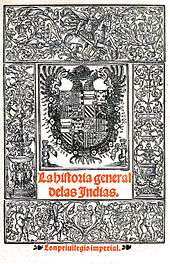Gonzalo Fernández de Oviedo y Valdés
Gonzalo Fernández de Oviedo y Valdés (August 1478 – 1557) was a Spanish historian and writer. He is commonly known as "Oviedo" even though his family name is Fernández. He participated in the Spanish colonization of the Caribbean, and wrote a long chronicle of this project which is one of the few primary sources about it. For three centuries, only a small portion of it was published, but this abridgement was widely read in the 16th century in Spanish, English, and French editions.
He was born in Madrid of a noble Asturian lineage and educated in the court of Ferdinand and Isabella. At thirteen, he became page to their son, the Infante John, Prince of Asturias. After the Prince's death (October 4, 1497), Oviedo went to Italy, and there acted as secretary to Gonzalo Fernández de Córdoba. In 1514 he was appointed supervisor of gold smeltings at Santo Domingo, and on his return to Spain in 1523 was appointed historiographer of the Indies. He paid five more visits to America before his death, which took place at Valladolid in 1557. At one point he was placed in charge of the Fortaleza Ozama, the famous fort in Santo Domingo, Dominican Republic, where there is a large statue of him, a gift to that country from a King of Spain.
Works
Oviedo's first literary work was a chivalric romance entitled, Libro del muy esforzado e invencible caballero Don Claribalte (Book of the very striving and invincible knight Don Claribalte). It was published in 1519 in Valencia by Juan Viñao, one of the prominent printers of that time. In the foreword, dedicated to Ferdinand of Aragón, Duke of Calabria (not to be confused with the King Ferdinand II of Aragon), Oviedo relates that the work had been conceived and written while he was in Santo Domingo. Therefore, it seems that this was the first literary work created in the New World.[1]

Oviedo wrote later two extensive works of permanent value, which for the most part were not published until three centuries after his death: La historia general y natural de las Indias and Las Quinquagenas de la nobleza de España. The former work was first issued at Toledo (1526) in the form of a summary entitled La Natural hystoria de las Indias; the first part of La Historia general de las Indias appeared at Seville in 1535; but the complete work was not published till 1851-1855, when it was edited by J.A. de los Rios for the Spanish Academy of History. The Quinquagenas is a collection of quaint, moralizing anecdotes in which Oviedo indulges in much lively gossip concerning eminent contemporaries. It was first published at Madrid in 1880, edited by Vicente de la Fuente.
The Historia, though written in a diffuse style, furnishes a mass of information collected at first hand. Las Casas, the fellow contemporary chronicler of the Spanish colonization of the Caribbean, denounced Oviedo and the Historia thus: "one of the greatest tyrants, thieves, and destroyers of the Indies, whose Historia contains almost as many lies as pages".[2] The incomplete Seville edition was widely read in the English and French versions published by Eden and Poleur, respectively, in 1555 and 1556.
It is through Oviedo's book that Europeans came to learn about the hammock, the pineapple, and tobacco, among other things used by the Native Americans that he encountered. The first illustration of a pineapple is credited to him. Shortly after Columbus was in Hispaniola, Oviedo visited there and saw the natives using green wooden stakes lashed to a frame over a smouldering fire for cooking. The Taino word for this device was "barbacoa". There were other changes to the word including the French "Boucane".
Notes
- ↑ Agustín G. de Amezúa. Introduction to the facsimile reprint of Libro de Claribalte by the Spanish Royal Academy, Madrid, 1956
- ↑ Liévano, 2002: 84
References
- Liévano Aguirre, Indalecio. 2002. Los grandes conflictos sociales y económicos de nuestra historia. Volumes 3-4. Bogotá: Intermedio.
- Attribution
 This article incorporates text from a publication now in the public domain: Chisholm, Hugh, ed. (1911). "Valdes, Gonzalo Oviedo Y". Encyclopædia Britannica (11th ed.). Cambridge University Press.
This article incorporates text from a publication now in the public domain: Chisholm, Hugh, ed. (1911). "Valdes, Gonzalo Oviedo Y". Encyclopædia Britannica (11th ed.). Cambridge University Press.